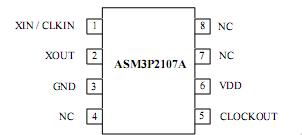ASM3P2107A: Features: FCC approved method of EMI attenuation. Generates a 1X low EMI spread spectrum clock of the input frequency. Input frequency range: 12MHz to 22MHz. Internal loop filter minimizes external ...
floor Price/Ceiling Price
- Part Number:
- ASM3P2107A
- Supply Ability:
- 5000
Price Break
- Qty
- 1~5000
- Unit Price
- Negotiable
- Processing time
- 15 Days
SeekIC Buyer Protection PLUS - newly updated for 2013!
- Escrow Protection.
- Guaranteed refunds.
- Secure payments.
- Learn more >>
Month Sales
268 Transactions
Payment Methods
All payment methods are secure and covered by SeekIC Buyer Protection PLUS.

 ASM3P2107A Data Sheet
ASM3P2107A Data Sheet







